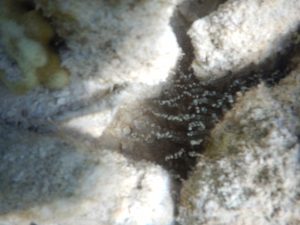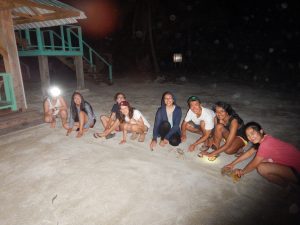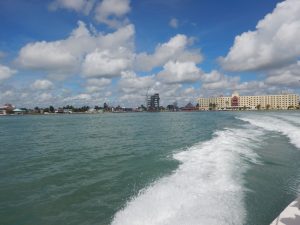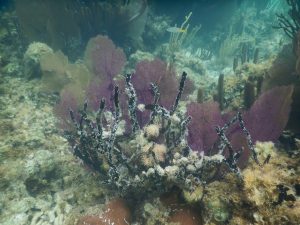I woke up at 3:45 this morning to prove that I was able to naturally able to wake up at whatever time I wanted before waking up at 6:00 to actually start my day. We ate breakfast before moving to the hammocks to work on our poster on our findings from day 10 and 11 about the hard coral coverage and sea urchins. We spent about three hours analyzing our data and writing up our poster before presenting to Scott and Javier. Afterwards, we started lectures with me giving my presentation on corallimorphs, zoanthids, and anemones. We ran out of time and had to break for lunch but came back and Sam gave his lecture on brown and red algae and Jessica gave hers on invasive species.
After lectures, we geared up sans fins and waded out off the shore into what felt like boiling water. As we got deeper, the water became colder and more and more organisms came out. We picked up conch shells to look for any small creatures that we put into Scott’s bucket. I focused on finding anemones and corallimorphs but I stumbled across a few cool green algae and conchs. We swam farther to the barrier reef, where the corals contained a ton of really cool critters. We saw two nurse sharks, a puffer fish, plenty of damselfish, a giant lobster, and some really cool corals. We swam around for about an hour and a half before heading back to the shore to analyze our creatures.

We took our buckets back to the wet lab and began sorting out our taxons. We found a big surprise with two small octopi that had been hiding in our shells and a small wrasse that seemed terrified of us. I took all of the anemones and the medusa worm into my bucket and worked to identify them. Sam, Jessica, Andressa, and Claire identified their critters as well before we presented to the rest of the class.
After we ate dinner, I showered and we all sat on the dock to watch the sunset, which was really nice. After, Javier gave us a presentation on the history and culture of Belize, which was super interesting, We all chilled by the hammocks after to work on notebooks while listening to music.
Corallimorphs, Zoanthids, and Anemones found: 7 giant Caribbean anemones seen in the shallow reef of both color morphs. They were either on conch shells or in the crevices of hard corals in the reef. They were mostly alone but a few were in close proximity to each other. Sun anemones, saw 3 10cm ones, 2 20cms and 1 40 cm one, either on the benthos or attached to rocks in the reefs. Many of these grew close to each other. Brown sponge zoanthid found in the coral near the barrier reef, hidden in a crevice. It formed a small mound near the floor of the coral.














